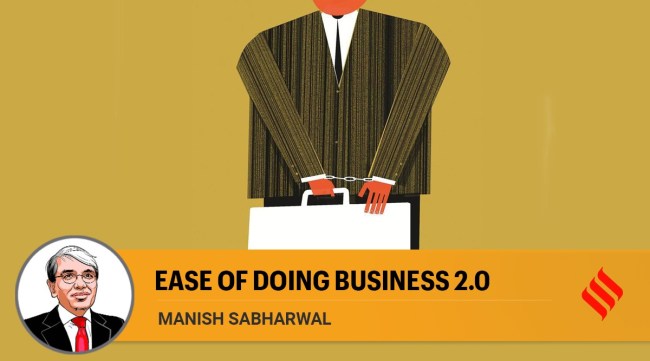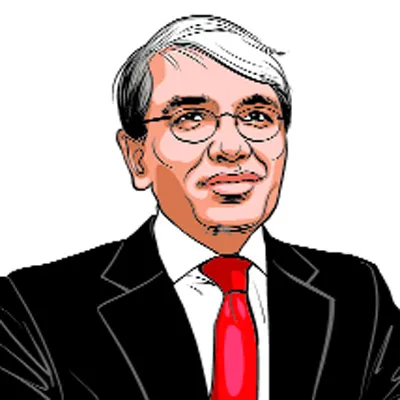Opinion Time to end employer criminalisation
Manish Sabharwal writes: Reducing the 26,134 jail provisions in employer compliance will reduce corruption, accelerate job creation, and improve justice.
 Excessive criminalisation accelerated in the mid-1960s in response to weak state capacity (Illustration by C R Sasikumar)
Excessive criminalisation accelerated in the mid-1960s in response to weak state capacity (Illustration by C R Sasikumar) The Vishnu Sahasranama presciently anticipated India’s 75-year journey to 26,134 employer jail provisions — Saha-srarchi sapta-jihvah saptai-dha sapta-vahanah, Amoorti ranagho chintyo bhaya-krudbhaya-nashanah (amateur translation: Fear is created so it can be taken away). This excessive criminalisation hasn’t created world-beating honesty or the world’s largest jail system but has painful consequences for corruption, formal jobs, and justice. The PM’s last Independence Day speech made lower regulatory cholesterol a policy priority: 22,000 citizen compliances have since been purged and the recent budget skillfully prioritised Ease of Doing Business (EODB) 2.0. This purge must extend to employer criminalisation for three reasons — corruption, formal jobs and justice.
A new paper titled Jailed for Doing Business by Gautam Chikermane of ORF and Rishi Agrawal of Teamlease Regtech painstakingly documents the imprisonment risks faced by Indian entrepreneurs across 1,536 laws in seven categories — labour, secretarial, environment health and safety, finance and taxation, industry-specific, commercial, and general. Eight hundred and forty-three laws have 26,134 criminal provisions. Fifty-five per cent prescribe more than one year of jail, 67 per cent have more than five jail provisions, and one law has 700 ways to end up in jail! Let’s dive into the case for purging:
Corruption: Joseph Stalin’s secret police chief Lavrenti Beria once said, “show me the man and I will find the crime”. Excessive and arbitrary power, combined with the ultimate power of putting or threatening to put people in jail, breeds corruption via transmission losses between how the law is written, interpreted, practised, and enforced. It is racist to believe that corruption is cultural. It arises when unreasonable or unfair policies combine with discretionary and weakly checked power to impose huge financial, social, or bodily damage. The deterrence of mutually assured destruction led to the Cold War never being fought but the jail deterrents in employer compliance are neither mutual nor unused. They are 26,134 asymmetric weapons used every day to extract money from the powerless.
Formal Jobs: India is poor not because we have a shortage of land, labour, or capital but a disease in how these three combine — what economists call Total Factor Productivity and the human race calls entrepreneurship or innovation. Putting India’s poverty in the museum it belongs needs raising the productivity of our regions (UP and Karnataka have the same GDP but a 75 per cent difference in population), firms (there is 24 times difference in productivity between our largest and smallest manufacturing firms), and individuals (we have a four-times difference in salary for same-age kids with the same paper qualification). An effective employer rule of law regime tackles information asymmetry, market power, negative externalities, and public good creation but must support the entrepreneurship that creates formal jobs that pay high wages as the fourth factor of production. Our 26,134 jail threats are deadly friendly fire on the kind of entrepreneurship that creates babies not dwarfs.
Justice: Courts have seen penalisation as a question of legislative wisdom but common-sense standards for criminalisation as “harm to others” have been suggested by academics like Andrew Ashworth and Joel Feinberg. Having 10 commandments (few tightly enforced) rather than tens of thousands of commandments (many selectively enforced) will empower the powerless. Philosopher John Ruskin suggested “Punishment is the last and least effective instrument …. for the prevention of crime”; adding 300 plus jail provisions every year for 70 years in labour laws has not protected our workers. And surely the lack of whitewashing, canteen committees, lime washing, spittoons, and filing returns don’t merit jail.
Excessive criminalisation accelerated in the mid-1960s in response to weak state capacity. But this criminalisation was counterproductive — it hurt what it was trying to help. State capacity diminished further and faster because jail provisions eliminate the skills and hard work that transparent enforcement requires. Conviction rates decline because of higher “beyond reasonable doubt” thresholds and voluntary quashing (under CPC Section 482) becomes a weapon for corruption. The criminalisation of employer compliances is not about employer versus employee but unaccountable arms of the state versus employers.

The timely and fair prosecution of wrongdoers will end the economically toxic narrative of imaandaar (honest) as bewakoof (fool) that currently encourages deals over-rules and breeds low paying-jobs. The central government is boldly reducing compliances and has asked state governments to mirror this rationalisation. In the long run, Parliament must set a more frugal tone with jail provisions and demand higher conviction rates from our economic investigative agencies so the law can move from anticipating future criminals with unenforceable deterrents to actually putting real criminals in jail. Reducing employer jail provisions will expand good job creation because, as Nobel Laureate Daniel Kahneman says, when we want to move faster we instinctively step on the accelerator but often get better results by releasing the brake.
The excessive criminalisation of employer compliances represents a dated “tug-of-war” metaphor between job creators and the state that vilifies entrepreneurs. It is now being replaced with a metaphor of a “dance” between partners with different, crucial, and complementary roles. Prime Minister Atal Bihari Vajpayee said, “I come from a political tradition that does not look upon commerce and industry with suspicion. When it was conventional political expediency to decry entrepreneurship, we championed their cause”.
In 1958 philosopher Isaiah Berlin distinguished between two types of freedom. Negative liberty is freedom from obstacles and interference by others. Positive liberty is freedom to control your own destiny and shape your own life. India has created the world’s largest democracy on the infertile soil of the world’s most hierarchical society on the strong foundations of the positive freedoms in our Constitution. But our negative liberty is blunted by the 26,134 criminal provisions for employers that breed corruption, sabotage formal job creation, and poison justice. Many must go.
This column first appeared in the print edition on February 11, 2022 under the title ‘Ease of doing business 2.0’. The writer is co-founder, Teamlease Services






